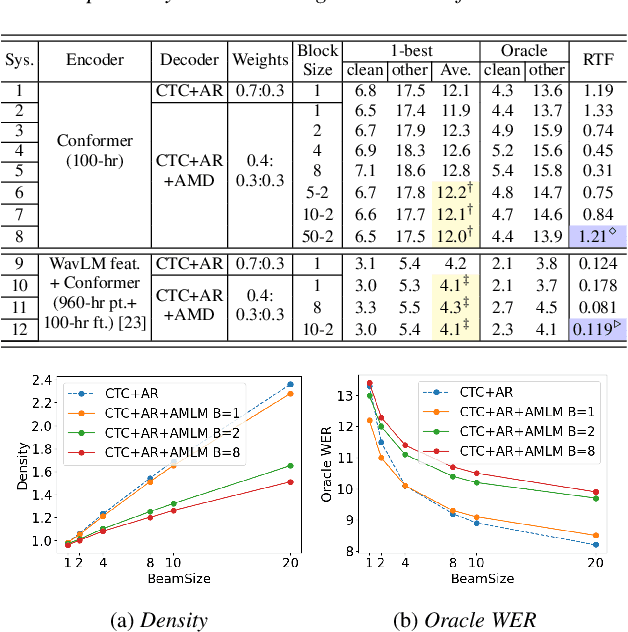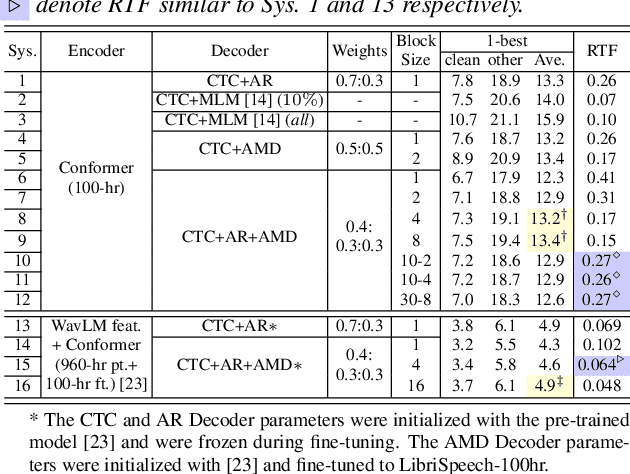Xurong Xie
Phone-purity Guided Discrete Tokens for Dysarthric Speech Recognition
Jan 08, 2025



Abstract:Discrete tokens extracted provide efficient and domain adaptable speech features. Their application to disordered speech that exhibits articulation imprecision and large mismatch against normal voice remains unexplored. To improve their phonetic discrimination that is weakened during unsupervised K-means or vector quantization of continuous features, this paper proposes novel phone-purity guided (PPG) discrete tokens for dysarthric speech recognition. Phonetic label supervision is used to regularize maximum likelihood and reconstruction error costs used in standard K-means and VAE-VQ based discrete token extraction. Experiments conducted on the UASpeech corpus suggest that the proposed PPG discrete token features extracted from HuBERT consistently outperform hybrid TDNN and End-to-End (E2E) Conformer systems using non-PPG based K-means or VAE-VQ tokens across varying codebook sizes by statistically significant word error rate (WER) reductions up to 0.99\% and 1.77\% absolute (3.21\% and 4.82\% relative) respectively on the UASpeech test set of 16 dysarthric speakers. The lowest WER of 23.25\% was obtained by combining systems using different token features. Consistent improvements on the phone purity metric were also achieved. T-SNE visualization further demonstrates sharper decision boundaries were produced between K-means/VAE-VQ clusters after introducing phone-purity guidance.
Structured Speaker-Deficiency Adaptation of Foundation Models for Dysarthric and Elderly Speech Recognition
Dec 25, 2024Abstract:Data-intensive fine-tuning of speech foundation models (SFMs) to scarce and diverse dysarthric and elderly speech leads to data bias and poor generalization to unseen speakers. This paper proposes novel structured speaker-deficiency adaptation approaches for SSL pre-trained SFMs on such data. Speaker and speech deficiency invariant SFMs were constructed in their supervised adaptive fine-tuning stage to reduce undue bias to training data speakers, and serves as a more neutral and robust starting point for test time unsupervised adaptation. Speech variability attributed to speaker identity and speech impairment severity, or aging induced neurocognitive decline, are modelled using separate adapters that can be combined together to model any seen or unseen speaker. Experiments on the UASpeech dysarthric and DementiaBank Pitt elderly speech corpora suggest structured speaker-deficiency adaptation of HuBERT and Wav2vec2-conformer models consistently outperforms baseline SFMs using either: a) no adapters; b) global adapters shared among all speakers; or c) single attribute adapters modelling speaker or deficiency labels alone by statistically significant WER reductions up to 3.01% and 1.50% absolute (10.86% and 6.94% relative) on the two tasks respectively. The lowest published WER of 19.45% (49.34% on very low intelligibility, 33.17% on unseen words) is obtained on the UASpeech test set of 16 dysarthric speakers.
Structured Dialogue System for Mental Health: An LLM Chatbot Leveraging the PM+ Guidelines
Nov 16, 2024



Abstract:The Structured Dialogue System, referred to as SuDoSys, is an innovative Large Language Model (LLM)-based chatbot designed to provide psychological counseling. SuDoSys leverages the World Health Organization (WHO)'s Problem Management Plus (PM+) guidelines to deliver stage-aware multi-turn dialogues. Existing methods for employing an LLM in multi-turn psychological counseling typically involve direct fine-tuning using generated dialogues, often neglecting the dynamic stage shifts of counseling sessions. Unlike previous approaches, SuDoSys considers the different stages of counseling and stores essential information throughout the counseling process, ensuring coherent and directed conversations. The system employs an LLM, a stage-aware instruction generator, a response unpacker, a topic database, and a stage controller to maintain dialogue flow. In addition, we propose a novel technique that simulates counseling clients to interact with the evaluated system and evaluate its performance automatically. When assessed using both objective and subjective evaluations, SuDoSys demonstrates its effectiveness in generating logically coherent responses. The system's code and program scripts for evaluation are open-sourced.
Homogeneous Speaker Features for On-the-Fly Dysarthric and Elderly Speaker Adaptation
Jul 08, 2024



Abstract:The application of data-intensive automatic speech recognition (ASR) technologies to dysarthric and elderly adult speech is confronted by their mismatch against healthy and nonaged voices, data scarcity and large speaker-level variability. To this end, this paper proposes two novel data-efficient methods to learn homogeneous dysarthric and elderly speaker-level features for rapid, on-the-fly test-time adaptation of DNN/TDNN and Conformer ASR models. These include: 1) speaker-level variance-regularized spectral basis embedding (VR-SBE) features that exploit a special regularization term to enforce homogeneity of speaker features in adaptation; and 2) feature-based learning hidden unit contributions (f-LHUC) transforms that are conditioned on VR-SBE features. Experiments are conducted on four tasks across two languages: the English UASpeech and TORGO dysarthric speech datasets, the English DementiaBank Pitt and Cantonese JCCOCC MoCA elderly speech corpora. The proposed on-the-fly speaker adaptation techniques consistently outperform baseline iVector and xVector adaptation by statistically significant word or character error rate reductions up to 5.32% absolute (18.57% relative) and batch-mode LHUC speaker adaptation by 2.24% absolute (9.20% relative), while operating with real-time factors speeding up to 33.6 times against xVectors during adaptation. The efficacy of the proposed adaptation techniques is demonstrated in a comparison against current ASR technologies including SSL pre-trained systems on UASpeech, where our best system produces a state-of-the-art WER of 23.33%. Analyses show VR-SBE features and f-LHUC transforms are insensitive to speaker-level data quantity in testtime adaptation. T-SNE visualization reveals they have stronger speaker-level homogeneity than baseline iVectors, xVectors and batch-mode LHUC transforms.
Towards Effective and Efficient Non-autoregressive Decoding Using Block-based Attention Mask
Jun 14, 2024



Abstract:This paper proposes a novel non-autoregressive (NAR) block-based Attention Mask Decoder (AMD) that flexibly balances performance-efficiency trade-offs for Conformer ASR systems. AMD performs parallel NAR inference within contiguous blocks of output labels that are concealed using attention masks, while conducting left-to-right AR prediction and history context amalgamation between blocks. A beam search algorithm is designed to leverage a dynamic fusion of CTC, AR Decoder, and AMD probabilities. Experiments on the LibriSpeech-100hr corpus suggest the tripartite Decoder incorporating the AMD module produces a maximum decoding speed-up ratio of 1.73x over the baseline CTC+AR decoding, while incurring no statistically significant word error rate (WER) increase on the test sets. When operating with the same decoding real time factors, statistically significant WER reductions of up to 0.7% and 0.3% absolute (5.3% and 6.1% relative) were obtained over the CTC+AR baseline.
Joint Speaker Features Learning for Audio-visual Multichannel Speech Separation and Recognition
Jun 14, 2024



Abstract:This paper proposes joint speaker feature learning methods for zero-shot adaptation of audio-visual multichannel speech separation and recognition systems. xVector and ECAPA-TDNN speaker encoders are connected using purpose-built fusion blocks and tightly integrated with the complete system training. Experiments conducted on LRS3-TED data simulated multichannel overlapped speech suggest that joint speaker feature learning consistently improves speech separation and recognition performance over the baselines without joint speaker feature estimation. Further analyses reveal performance improvements are strongly correlated with increased inter-speaker discrimination measured using cosine similarity. The best-performing joint speaker feature learning adapted system outperformed the baseline fine-tuned WavLM model by statistically significant WER reductions of 21.6% and 25.3% absolute (67.5% and 83.5% relative) on Dev and Test sets after incorporating WavLM features and video modality.
Perceiver-Prompt: Flexible Speaker Adaptation in Whisper for Chinese Disordered Speech Recognition
Jun 14, 2024Abstract:Disordered speech recognition profound implications for improving the quality of life for individuals afflicted with, for example, dysarthria. Dysarthric speech recognition encounters challenges including limited data, substantial dissimilarities between dysarthric and non-dysarthric speakers, and significant speaker variations stemming from the disorder. This paper introduces Perceiver-Prompt, a method for speaker adaptation that utilizes P-Tuning on the Whisper large-scale model. We first fine-tune Whisper using LoRA and then integrate a trainable Perceiver to generate fixed-length speaker prompts from variable-length inputs, to improve model recognition of Chinese dysarthric speech. Experimental results from our Chinese dysarthric speech dataset demonstrate consistent improvements in recognition performance with Perceiver-Prompt. Relative reduction up to 13.04% in CER is obtained over the fine-tuned Whisper.
Towards Automatic Data Augmentation for Disordered Speech Recognition
Dec 14, 2023Abstract:Automatic recognition of disordered speech remains a highly challenging task to date due to data scarcity. This paper presents a reinforcement learning (RL) based on-the-fly data augmentation approach for training state-of-the-art PyChain TDNN and end-to-end Conformer ASR systems on such data. The handcrafted temporal and spectral mask operations in the standard SpecAugment method that are task and system dependent, together with additionally introduced minimum and maximum cut-offs of these time-frequency masks, are now automatically learned using an RNN-based policy controller and tightly integrated with ASR system training. Experiments on the UASpeech corpus suggest the proposed RL-based data augmentation approach consistently produced performance superior or comparable that obtained using expert or handcrafted SpecAugment policies. Our RL auto-augmented PyChain TDNN system produced an overall WER of 28.79% on the UASpeech test set of 16 dysarthric speakers.
Factorised Speaker-environment Adaptive Training of Conformer Speech Recognition Systems
Jun 26, 2023



Abstract:Rich sources of variability in natural speech present significant challenges to current data intensive speech recognition technologies. To model both speaker and environment level diversity, this paper proposes a novel Bayesian factorised speaker-environment adaptive training and test time adaptation approach for Conformer ASR models. Speaker and environment level characteristics are separately modeled using compact hidden output transforms, which are then linearly or hierarchically combined to represent any speaker-environment combination. Bayesian learning is further utilized to model the adaptation parameter uncertainty. Experiments on the 300-hr WHAM noise corrupted Switchboard data suggest that factorised adaptation consistently outperforms the baseline and speaker label only adapted Conformers by up to 3.1% absolute (10.4% relative) word error rate reductions. Further analysis shows the proposed method offers potential for rapid adaption to unseen speaker-environment conditions.
Use of Speech Impairment Severity for Dysarthric Speech Recognition
May 18, 2023Abstract:A key challenge in dysarthric speech recognition is the speaker-level diversity attributed to both speaker-identity associated factors such as gender, and speech impairment severity. Most prior researches on addressing this issue focused on using speaker-identity only. To this end, this paper proposes a novel set of techniques to use both severity and speaker-identity in dysarthric speech recognition: a) multitask training incorporating severity prediction error; b) speaker-severity aware auxiliary feature adaptation; and c) structured LHUC transforms separately conditioned on speaker-identity and severity. Experiments conducted on UASpeech suggest incorporating additional speech impairment severity into state-of-the-art hybrid DNN, E2E Conformer and pre-trained Wav2vec 2.0 ASR systems produced statistically significant WER reductions up to 4.78% (14.03% relative). Using the best system the lowest published WER of 17.82% (51.25% on very low intelligibility) was obtained on UASpeech.
 Add to Chrome
Add to Chrome Add to Firefox
Add to Firefox Add to Edge
Add to Edge